The Bones of All Men
by Philip Pickett and Richard Thompson
[Music CD]
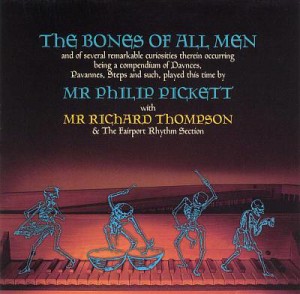
view/request
This album marries two of my favorite genres of music: specifically, 16th century Renaissance dances and British folk-rock of the 1960s and ’70s.
Richard Thompson and some ex-Fairport Convention comrades joined conductor and multi-instrumentalist Philip Pickett (who has Albion Band credentials as well as early music) in 1998 to rock out on a selection of tunes by William Byrd’s contemporaries. When I used to play electric harpsichord for English Country Dancing back in the early ’90s, this was the sort of sound I dreamed of achieving. Imagine a note-perfect recorder consort accompanied by Dave Mattacks on drums, or dueling krumhorn and electric guitar, or virginal with a very electrified bass continuo. The tunes are brilliantly arranged, irresistibly driving, reverently irreverent (or vice versa), passionately fun and absolutely classic in every sense of the word. Turn it up, way up.
Reviewed by Faith
Tagged: Early music, Rock music
Welcome to the Monkey House
[DVD]
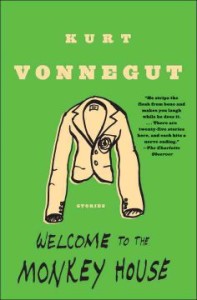
view/request
Selections from Kurt Vonnegut Jr.’s Welcome to the Monkey House, an anthology of shorter fiction, appeared on the Showtime channel in the early 1990’s. The series was on the air for a brief time, but all of the episodes exist on a dvd that we’ve just received from the Pleasant St. Video collection.
Welcome to the Monkey House is fascinating from the outset; the author makes an on camera introduction to the episodes. His opening dialog is the only instance of seeing him on film/tape that I can recall (until this moment, I’ve used my imagination to estimate his mannerisms via book jacket photographs!).
The stories and the overall feel of the series strike a kinship with David Lynch and Mark Frost’s Twin Peaks. Both idiosyncratic television programs were on the air around the same time, draw from 1950’s style and also deal with the abnormal. A mysterious double life, a sadistic battle of wits involving humans as chess pieces, a woman’s obsession with home design catalogs and a child’s eventful night without a babysitter all feature in Welcome to the Monkey House.
Vonnegut has always struck me as someone who has the ability of skillfully introducing science fiction elements or ideas into his writing without having them seem far removed from contemporary society. Though he often delves into the world of science fiction, I can’t classify him solely as a science fiction writer. His laconic central characters tend to ease us into strange, new worlds by having a dark sense of humor or an overall surly, sarcastic attitude toward the present state. For instance, a soap opera actor portraying a doctor is lead into mansion that houses an elderly woman whose only original body part is her head. The actor is initially surprised, but accepts the situation within moments after the orchestrator of this scientific achievement gives his explanation in the most blasé fashion possible.
Kurt Vonnegut’s stories are wonderfully captured in this series and feature performances by Madeline Kahn, Frank Langella, Jon Cryer and many more fine character actors. It was a short lived television program, but it managed to capture some of the author’s bizarrely brilliant concepts.
Reviewed by Jason
Tagged: Drama, Fiction, Humor, Science fiction
Glorious
by Eddie Izzard
[DVD]

view/request
I love Eddie Izzard’s stand-up. In Glorious he lopes across the stage imitating an evil giraffe, he runs in mock fright exclaiming, “I’m covered in bees!”, and he delivers a stream of unconventional witticisms, comical sound effects, and insightful observations.
Eddie’s jokes are carefully written but his delivery is casual and off the cuff. His jokes often rely on gesture and facial expressions, never more so than in his routine on “machines that lie”, during which he mimes the frustrations of making good toast and demonstrates the visual similarity between someone adjusting the tap in a shower and a safebreaker. (He ends this routine with a wonderful visual pun which I will refrain from describing—you will appreciate it better if it takes you by surprise.)
I don’t care much for stand-up, but I make an exception for Izzard’s smart, irreverent, performances. His shows are always entertaining andGlorious is one of his best.
Reviewed by Ben
Tagged: Comedy
Return To Cookie Mountain
[Music CD]
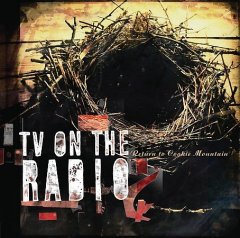
view/request
Return To Cookie Mountain (2006), by the Brooklyn-based quintet TV On The Radio, was my introduction to this group’s music and I quickly became a fan. I really enjoy the unique harmonies and vocal layerings of the two primary vocalists Tunde Adebimpe and Kyp Malone. The melodies are also exceptional and have been described as “atmospheric” and “spacious” Their music is not easy to categorize but some close approximations include: indie-rock, soul and trip-hop. Repeated listenings to this CD always reveal more pleasurable discoveries of their unique sound. Two outstanding tracks for me are “I Was A Lover” and “A Method”.
Reviewed by Susana
Tagged: Indie rock, Rock music
Louis C.K. : Hilarious
[DVD]
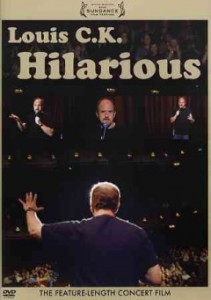
view/request
If you are easily offended by delicate or obscene subject matter, this 2010 concert film is, clearly, blatantly, spectacularly… not for you. Come to think of it, if you are offended by ANY words, in and of themselves, regardless of context, you may want to look elsewhere. It’s not that Louis is un-necessarily mean spirited or seeks to offend (well, except that he admittedly is and does, admitting at one point herein that shocking people makes him laugh) but he will leave many people squirming in their seats, probably laughing inside, but uncomfortable, to be sure. To those that love Louis C.K. , and I count myself strongly among them, his latest hour is the pinnacle of years of discipline and work on the road . It is the first Stand-Up film ever to be accepted at Sundance and the first stand-up comedy film in decades to show in theaters.
Unlike most working comics, Louie has been creating a completely new hour of stand-up every year, abandoning all older material, testing new routines every spring and summer in clubs and theaters before filming an hour special when his new hour is fully developed. Despite the obvious shock factor in many of the bits, what makes his comedy work so well is the surprising heart and thought that go into the writing, and the natural, “I just thought of this and I’m going to share it with you” delivery . When you are watching Louis perform at his best, you see the exasperated self-loathing character he describes and believe in it fully, to the point where you forget that he performs the act night in and night out, and it can be unsettling to see the same joke performed again elsewhere. Much of the best material he has used in his last few specials have been inspired by his role as a devoted father of two daughters and the experience of his recent divorce. When he delivers lines about the ridiculous anger and exasperation many parents feel but never openly express, it is always obvious and without question how much he loves his own children. While he brilliantly and savagely mocks the stupidity and spoiled impatience of modern day America, he saves his strongest contempt for himself.
The best stand-up is often that which lays bare the desperation and pain of our brief and ridiculous moment on earth and allows us to laugh at the most fragile and childish of our own instincts. At its best this film recalls some of the finest moments of his heroes, Pryor’s ability to make us laugh at his most painful moments and Carlin’s ability to dissect the absurdity of his time and make us see and laugh at ourselves. The film, however, is 100% Louie, and is the painfully funny work of a stand-up at the height of his powers.
Reviewed by Dylan
Tagged: Cell phones, Comedy, Divorce, Fatherhood, Obscenity, Parenting, Stupidity
Wheel of Time
by Werner Herzog
[DVD]
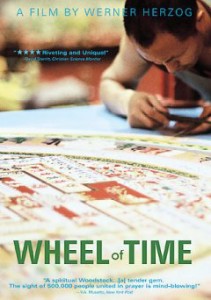
view/request
Werner Herzog, director of Fitzcarraldo, Aguirre: the Wrath of God and Stroszek, has almost become equally as famous for his non-fiction work in recent years thanks to the success of the fabulous Grizzly Man documentary. Forbes Library is fortunate to be receiving several of Herzog’s documentaries (many of which currently hard to find, out of print titles) through our acquisition of the Pleasant St. Video collection thanks to the kind donations from our patrons.
I first saw Wheel of Time at a Werner Herzog retrospective in Austin, TX. I must confess that I didn’t know much about the film or this German auteur at the time. I would soon receive a wonderful education by purchasing a pass to attend the rest of the festival and also borrowing everything I could find by the director at the video library where I was then employed.
The film chronicles a Buddhist pilgrimage to Bodh Gaya, India. At this destination, several artists create a giant, yet intricate, sand design or “sand mandala” (which is referred to as the wheel of time). The creation of the sand mandala is carefully constructed over a lengthy period of time and the viewer is constantly worried that it will not be completed by its deadline (or at least I was feeling tense). The stunning landscape along our travelers’ journey and the vibrant colors of the dyed sand are brilliantly captured by the film’s gorgeous cinematography. There is also a personal interview Herzog conducts with the Dalai Lama.
Wheel of Time, along with many of his documentaries, is certainly as interesting and entertaining as his classic fiction films. In both mediums, we are often supplied with adventure, drama, social commentary, humor and taken to exotic locales. Whether going up in a strange flying apparatus into a rainforest canopy, living in the jungle while filming, hauling a riverboat up a mountain, eating his own shoe, working with wild bears and collaborating with Klaus Kinski (!), Werner Herzog has managed to survive and also produce great art. It wasn’t until a 2006 BBC interview when his life became (arguably) most in danger when a sniper opened fire with an air rifle. After the shooting Herzog calmly commented, “it was not a significant bullet. I am not afraid.”
Reviewed by Jason
Tagged: Buddhism, Documentary, International
The Illusionist
by Sylvain Chomet
[DVD]
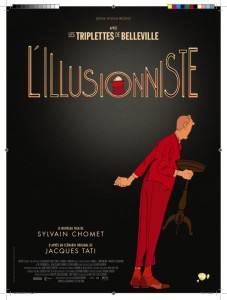
view/request
The Triplets of Belleville animator/director takes on an unrealized script of the late French comedian, writer and director Jacques Tati in the Illusionist. This remarkable, melancholic film features an animated Tati in the role of the magician named Tatcischeff (Tati’s actual last name) at a time when vaudeville performances are beginning to become a passé form of entertainment.
On a trip to Scotland for an appearance, Tatcischeff meets a young girl who winds up following him to London. The magician takes her under his care and winds up going broke funding her desire for expensive clothing. The two also come into contact with several eccentric and delightful characters surrounding the changing 1960’s entertainment industry.
What we have in the Illusionist is a funny, elegant and moving film which marries the essence of Jacques Tati’s brilliance and the stylish animation of Sylvain Chomet.
Reviewed by Jason
Tagged: Animation, Comedy, Feature film
A Wizard, A True Star
by Todd Rundgren
[Music CD]

view/request
Todd Rundgren, hot off the heels of Something/Anything? and its hits “Hello It’s Me” and “I Saw the Light”, released an experimental album called A Wizard, A True Star in 1973. The record is a strangely assembled pastiche of synthesizer driven pop songs, homages to Disney soundtracks and wacky Spike Jones records, soul covers and dark, personal compositions.
Nearly all of the songs run together on this recording creating a frantic, but inspired listening experience. Ever the innovative musician and producer, Rundgren’s engaging arrangements and subtle overdubs make this record a gratifying headphone listen.
Reviewed by Jason
Tagged: Experimental, Rock music
Live at the Star Club Hamburg
by Jerry Lee Lewis
[Music CD]
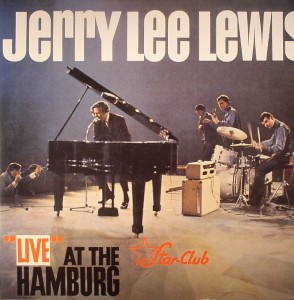
view/request
Live albums are always tricky; sure, a lot of your favorite songs appear on the track listing, but often the magic isn’t quite there. Artists often issue live recordings as an inexpensive way to fulfill contracts with their record labels. A certain magic can be missing from the original studio recording or you’re just left with poor sound quality.
Live at the Star Club Hamburg happens to be one of the exceptions to this trend. Backed by the Nashville Teens, Jerry Lee Lewis delivers one of the fiercest live concerts that has ever been captured on tape. The piano, much like the drums, is an instrument where physicality can be a variable. A musician’s force has much to do with the overall sound. Jerry Lee, sounding possessed (and possibly a little in the bag), pounds like a piano with fury and rage like it’s his last night to raise hell on Earth.
For some context, it’s 1964 and the the British Invasion is in full force. The Beatles had taken Hamburg by storm a couple of years back. Army stints, jail time, religious conversion and death put an end to most of the original 1950’s rockers. The Killer also had his share of controversy when he married his 13 year old cousin while still legally bound to another woman. The days of chart topping hits probably seemed like a distant past.
What does Jerry Lee do then? Well, he heads out to a small stage in Hamburg and plays one of the most aggressive sets ever heard. The crowd is in a frenzy throughout his set chanting “Jerry! Jerry! Jerry!” while he rolls over songs that were personal hits like “Great Balls of Fire” and “Whole Lotta Shakin’ Goin’ On” and popular favorites of his contemporaries such as “Long Tall Sally”, “Matchbox” and “Hound Dog”. Essentially, he’s delivering a similar song selection as the Liverpudlians brought with them to Germany; only Lewis is far more aggressive and is perhaps trying to prove that he’s an original rocker.
Fans of 50’s rock n’ roll will certainly enjoy this record. I also feel comfortable recommending Live at the Star Club Hamburg to fans of more raw groups like the Stooges or the MC5.
Reviewed by Jason
Tagged: 1950s rock music, Live recordings
Plastic Ono Band
by John Lennon
[Music CD]
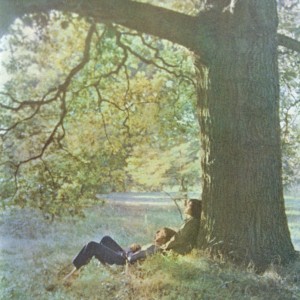
view/request
The Plastic Ono Band LP is commonly referred to as the “Primal Scream” album as John and Yoko were going through Arthur Janov’s Primal Scream therapy during the album’s creation in 1970. While Lennon’s lyrics had been hinting at the pain of his childhood since “Help” and “I’m a loser”, on Plastic Ono Band he becomes overtly confessional and addresses directly the disillusionment and isolation of fame and the overwhelming pain of his youth. The cryptic and surreal wordplay that characterized many of John’s contributions to the Beatles albums of the late 60’s is abandoned here and the results are split equally between straightforward quiet love songs (“Hold on”, “Love” and “Look at Me” which more closely resemble his fingerpicked contributions from 1968 such as “Julia” and “Dear Prudence”), filthy distorted rockers (“I Found out” and “Well, Well, Well” which share the heavy tube distortion sounds of “Revolution” and “Cold Turkey”) and epic declarations of loss and rebirth (“Mother” and “God”, both of which feature ‘simple’ piano/bass/drums arrangements). Released in October 1970, in the wake of Altamont, Manson and Kent State, “Plastic Ono Band” addresses the disillusionment of the end of the sixties, the break-up and dispelling of the Beatles myth and the tragedies of John’s childhood. Opening with the intense primal therapy of “Mother” (in which John finally overtly addresses his feelings of abandonment as a child and his mother’s sudden death just as they were reconciling) and closing with the myth-busting “God”, the album is easily Lennon’s most cohesive solo work. Lennon famously hated the sound of his own voice unadorned, and was constantly imploring producers to swathe it in reverb or other effects, and his most famous Beatles contributions were often dense, sonically experimental psychedelic studio creations. On Plastic Ono Band, stripped of daft wordplay and overproduction (Phil Spector, who produced half the sessions, is most notable here for his uncharacteristic restraint), with exceptional accompaniment by Ringo Starr, Billy Preston and Klaus Voorman, Lennon produces his most complete raw and honest solo work.
Reviewed by Dylan
Tagged: Beatles, Classic rock, John Lennon
Electric Ladyland
by The Jimi Hendrix Experience
[Music CD]

view/request
You find yourself alone, lying in a field of flowers. You’ve just been awoken by the distant pounding of what sounds like a tympani. Looking ahead, your feet seem miles away and a group of bunnies are gnawing on your blue jeans. Jimi once rapped, “Ho hum. I’m as good as bunnies- and you know how good bunnies are.” Just shake ‘em off, brother or sister; they’re just hungry after a long, hot summer night. The drum fades and nature, and in fact everything you hear as well, is moving backward. Fear not, you’re in Electric Ladyland, friend. Have you ever been?
Take out that note from your back pocket. No matter the urge to call the telephone number written on there, trust me, you don’t want to see Little Miss Strange again. Rip it to shreds.
Spend the next fifteen minutes drying yourself off from the still raining, still dreaming sky with the Experience in concert, floating somewhere in the the astral plane. “Voodoo Chile” is the jam. Look left and see a Marshall stack and a white Fender Strat resting comfortably. It’s been tuned and awaiting on you, man. Put the strap on over your shoulder (and make sure you’re going lefty), pick the open A-string (that’s the second heaviest on the axe), let it ring and move on over toward the amplifier. Things will start buzzing and feeding back some brilliant musical colors and waveforms. Mitch and Noel should be launching off that any minute now.
A singular door will appear in the middle of the field somewhere behind you. Open it and look out into outer-space with those Gypsy eyes. Grab the burning midnight lamp, step out and be mindful of the crosstown traffic. Mr. Dylan’s “All Along the Watchtower” is your soundtrack… and your guide, baby.
Keep the sounds of Electric Ladyland steady and you’ll find your way.
Reviewed by Jason
Tagged: Classic rock, Psychedelic
Black Books
[DVD]
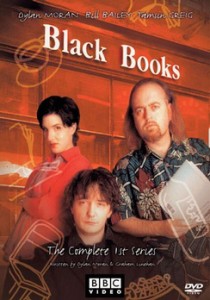
view/request
Irish comedian Dylan Moran stars in the BBC television series Black Books. The show was written and created by Moran and the folks who brought us Father Ted.
Bernard Black, a cranky and boozy book shop owner, wants absolutely nothing to do with his customers and does very little to aid his decaying store. He’s joined by his friend and neighboring shop employee, Fran and Manny, his hapless, but loveable (possibly unpaid) employee. We join these three on many madcap adventures and exercises in generally poor customer service. While a fair amount the gags fall under the customer/employee dynamic or displays of tremendous laziness, we also get a fair amount of surreal humor.
Reviewed by Jason
Tagged: British TV, Comedy












